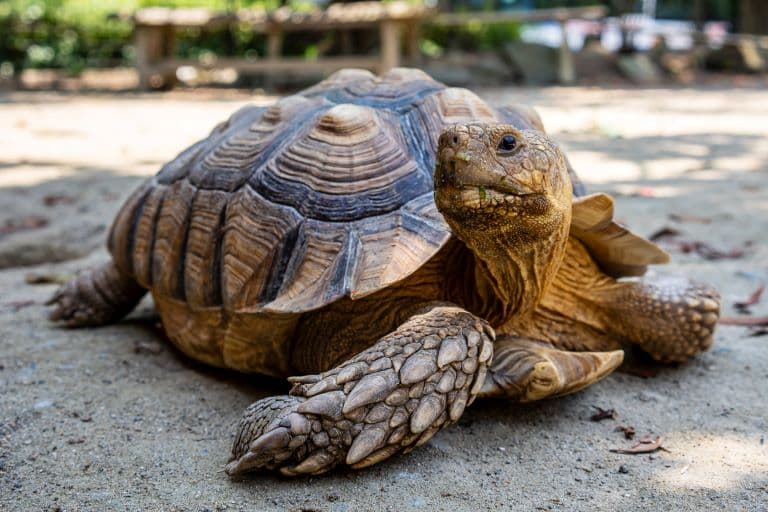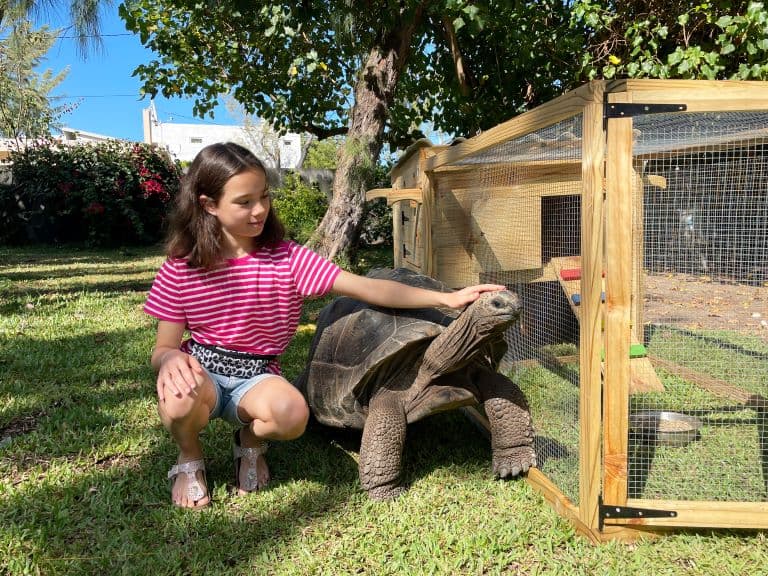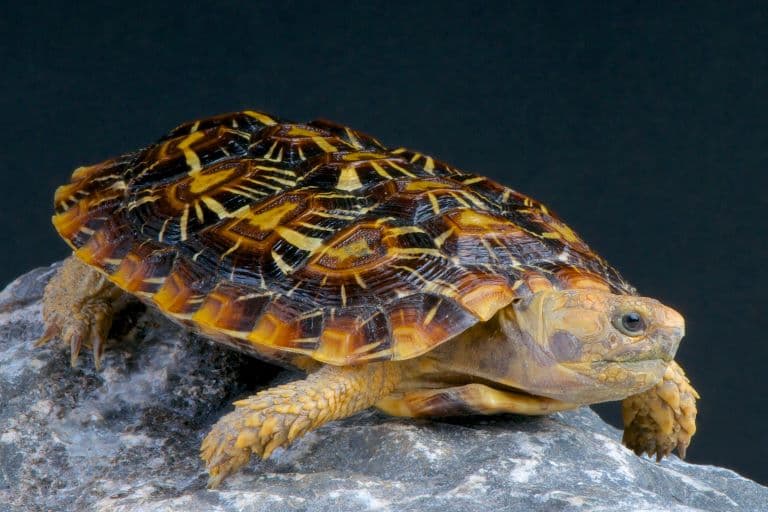Tortoise Profile
The Neverending Story by the ironically-named Michael Ende speaks of “Die Uralte”, or The Ancient One, Morla, who is the wisest and oldest being in Fantasia.
Morla is so old, she is allergic to young people, and in the book, she’s a giant, swamp-dwelling ‘turtle’ and has been alive for so long she’s become jaded to the destruction of her world and relatively slow and indifferent to its (and her own) demise.
The depiction of this ancient Testudine has even more parallels with the reality of terrestrial turtles today than was likely known in the ‘70s when the book was written, and aside from being smart, Morla’s similarities with the reality of the tortoise are tragically familiar.

Tortoise Facts Overview
| Habitat: | From desert to forest |
| Location: | Americas, Africa, Eurasia an the Pacific Islands |
| Lifespan: | More than 188 years |
| Size: | 6.8cm (2.7 in) in smallest, to 1.2m (4 ft) long in largest species |
| Weight: | Up to 300 kg (700lb) |
| Colour: | Usually yellow/green/browns |
| Diet: | Generally herbivorous but will eat invertebrates sometimes |
| Predators: | Hawks, humans |
| Top Speed: | Less than 1.6 km/h (1mph) |
| No. of Species: | Around 50 |
| Conservation Status: | Many are critically endangered (IUCN) |
Tortoises are a widespread group of terrestrial turtles whose long history of moving slowly and looking really, really old has placed them into symbolic positions in various ancient human cultures.
But they’re not likely as smart as their age would suggest, and not necessarily as gentle, either.
Regardless, they are entirely harmless to humans, and their decline at the hands of hunters and exotic pet collectors seems a little unfair.
Interesting Tortoise Facts
1. They’re terrestrial turtles!
The difference between a tortoise and a turtle isn’t as complicated as the confusion around it would suggest. Turtles are testudines, an order of shelled reptiles that’s separate from the snakes and lizards or the crocodilians.
Some people call all testudines turtles, whether they live on land or in the water, others refer to the terrestrial turtles as tortoises, and withhold the word turtle for those that swim. So, while all tortoises are turtles, not all turtles are tortoises.
2. They can be huge
Being turtles, they’re part of a group of reptiles that get very large. In fact, the third-largest reptile is a sea turtle, and tortoises can get pretty huge themselves.
There were once several groups of giant tortoises all over the world, but today there are only two: the Galapagos and the Aldabra giant tortoises. These are both island species, and generally weigh over 250kg.
A large adult male Galapagos tortoise can weigh over 300 kg, and while there used to be over 250,000 of them on the islands, there are now fewer than 15,000 as a result of over-exploitation for their meat and shells and the destruction of their habitat.

3. And they can live for a long time
In general, most tortoise species can live 80–100 years, but some of these enormous guys have been known to last a lot longer.
Johnathan the tortoise, a Seychelles tortoise, is said to be 191 years old, and there are photos of him from back when pith helmets were still an appropriate headgear in Africa. He’s so well respected that he’s made it onto one of the coins from St. Helena. 1
4. They’re slow
Tortoises are lumbering animals, whose shell prevents much of the agility needed to do anything quickly. As well as being slow to grow and age, they’re also slow to move and to reproduce.
Most start from small clutches of eggs, perhaps only one or two. Incubation may last up to 160 days, after which they may grow only by a couple of centimetres each year. When they reach maturity, their growth slows down but some larger species will continue to get bigger for decades.
Others will stop growing at around ten years old. 2
5. They’re symbolic
Such slow and ancient animals have inspired many legends around them. They’re a symbol of luck, of longevity, and of the wisdom that comes from it.
In Hindu and Chinese mythology, the Earth is carried on a tortoise, and an extinct species of giant tortoise shows up a lot in Ancient Egypt’s artwork and in symbolic burial palettes. Tortoises and Nile turtles appear in protective amulets and are also sometimes the enemy of the sun god, Re.
6. But they’re quite dumb
Despite all this, tortoises are far from wise. Brain power isn’t much use to an animal who moves slowly and eats lettuce, and the tortoise brain of a tortoise is proportionally small.
Some don’t have a hippocampus at all, which suggests a limit to how much they can process emotion, or learn (although different animal brains have compensatory regions for this).
A strange and classic experiment from the 17th century showed that a tortoise can live for around six months with its brain removed. Alarmingly, their bodies remained ‘alive’ for 23 days even with the entire head removed.
From “Leaves from the Note-book of a Naturalist” by William John Broderip in 1852, these events were described in more detail:
“The tenacity of life with which the Testudinata are gifted would be hardly credible to those who have not closely studied the subject.
No well- regulated mind can read of some of the experiments which have been made to place the fact beyond all doubt without being shocked; but averse as every good man must be to the infliction of pain or death, it is but fair to allow that such experiments may be more cruel in appearance than in reality…
“In the beginning of November he opened the skull of a land-tortoise, removed every particle of brain, and cleaned the cavity out.
The animal was then set at liberty, but, instead of dying or remaining motionless, it groped its way about freely as its inclination directed, without the aid of sight; for when the animal was deprived of its brain it closed its eyes, which it never opened afterwards.
The wound was left open, but skinned over in three days, and the tortoise continued to go about till the middle of May, when it died.”
7. They’ll kill things
But it’s not all lettuces and lethargy, these freaky, old, brainless reptiles are happy to kill when they get the chance.
Herbivores are more like transitioning vegans than the die-hard plant-based radicals who think Tottenham is an offensive word. As such, they are almost exclusively oriented around vegetation, but sometimes the temptation for animal protein is too much and they’ll make an exception.
As such, a horse will happily eat a cheeseburger if it’s fed one, and a cow will eat a chicken (which adds a morbid potential to the Cartoon Network show). And for reptiles, the line is even more blurred.
So, it shouldn’t be surprising that a grizzly scene from the Seychelles of an Aldabrachelys giant tortoise devouring a baby bird. 3
8. There used to be a lot more
Tortoises are relatively widespread on Earth, but the 50 or so species remaining today are a fraction of what once was.
Of the giant tortoises, only the two species remain, but it wasn’t long ago that huge animals like this were found on almost all large island chains.
Most of these became giants after floating to the islands and spending millions of years there with plentiful food and few predators, but when humans arrived on these land masses, they were quickly hunted to extinction.
Smaller tortoises have fared a little better, but many of these species, too, including the amusingly named pancake tortoise and the elongated tortoise, are now critically endangered. Smaller tortoises are primarily threatened by the exotic pet trade, being taken from the wild to supply high demand in captivity.

Tortoise Fact-File Summary
Scientific Classification
| Kingdom: | Animalia |
| Phylum: | Chordata |
| Class: | Reptilia |
| Order: | Testudines |
| Family: | Testudinidae |
Fact Sources & References
- “TORTOISE (GALAPAGOS)”, Young People’s Trust For the Environment.
- Samantha Harris (2023), “HOW LONG DO BABY TORTOISES STAY SMALL? (GROWTH CHART + SIZES)”, Tortoise Knowledge.
- (2021), “A carnivorous giant tortoise”, The Economist.
